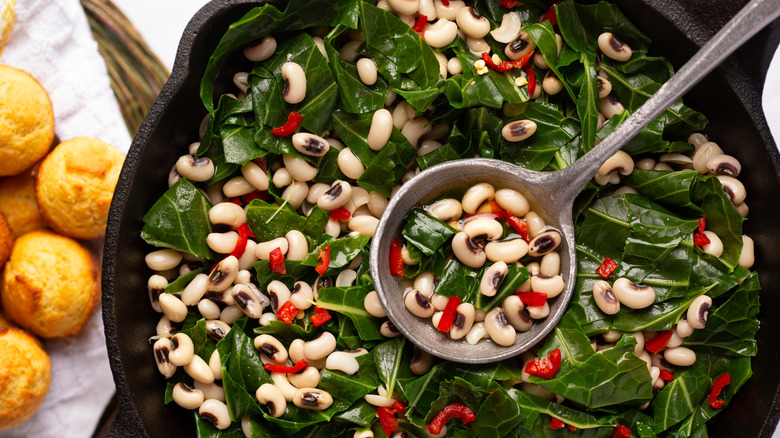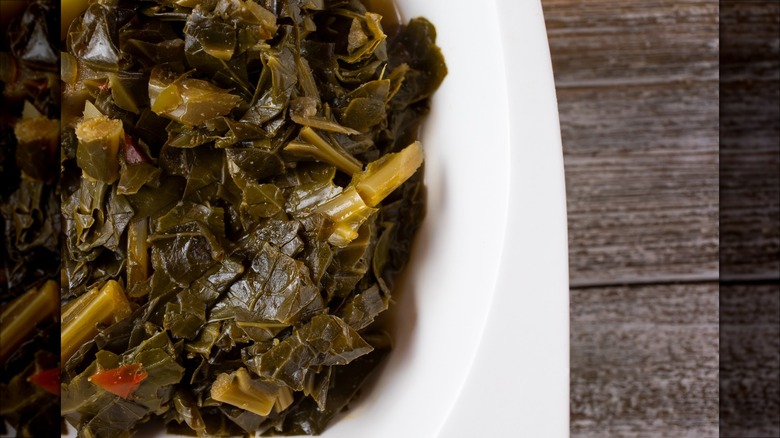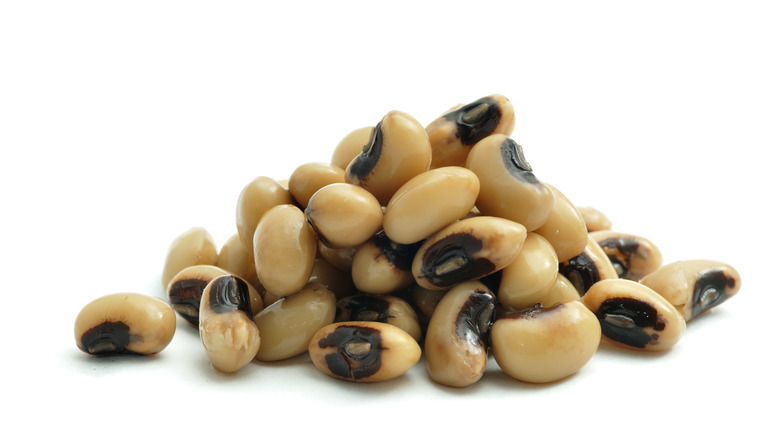The Significance Behind Black-Eyed Peas And Collard Greens During Kwanzaa
Kwanzaa is an end-of-year holiday to celebrate the heritage of and unity within Black culture and was created in 1966 by Dr. Maulana Karenga, a professor and activist. It takes place from December 26th through January 1st of each year. Centered around seven guiding principles (unity, self-determination, collective work and responsibility, cooperative economics, purpose, creativity, and faith) known as the Nguzo Saba, celebrations occur across the week and each day that passes is commemorated with the lighting of black, red, and green candles along the Kinara.
Like many holidays, food is an important part of the yearly Kwanzaa celebration, and though many major dishes are a part of the holiday, two of the most heralded are collard greens and black-eyed peas. These dishes are not only an iconic aspect of Kwanzaa cuisine, but they are versatile and delicious, especially when served with a hefty piece of cornbread to go with them. Their significance isn't just based on their satisfying taste, but is rooted in a much deeper tradition. We'll take a closer look at the importance of collard greens and black-eyed peas to this special time of year, and find out what these amazing foods represent.
Collard greens symbolize good fortune
In the tradition of Kwanzaa, the preparation and consumption of collard greens are meant to symbolize good fortune throughout the year. These greens are typically stewed in broth, either meat-based or veggie, and other aromatics and spices for about two hours. In that time, the leafy greens have absorbed the sumptuous tastes of the surrounding flavors and provide a hearty, filling holiday meal. According to Appetite for Change, the greens are hardy crops, able to endure growth in even the harshest weather conditions, which is meant to reflect the never-ending resilience and perseverance of the Black community in the face of adversity throughout history. This is amplified by the fact that we're able to use this dish in American cuisine due to the historical roots in the Transatlantic slave trade, when enslaved Africans brought their knowledge of cooking with the collard plant from Africa, ushering it into the modern culinary parlance of Southern cooking.
Collard greens can be prepared in any number of interesting ways, but they are most commonly chopped and cooked down until they are soft and almost soup-like. Often served with a generous piece of meat and a slice of the aforementioned cornbread, greens are not only nutritious, but they bring out the best in anything else in your Kwanzaa dinner that may surround them. That, along with the good fortune they're said to bring, makes collards something no Kwanzaa dinner should go without.
Black eyed peas signify good luck
Representing good luck in the coming year, black-eyed peas are a similarly revered part of any Kwanzaa feast. Like greens, they are an indispensable food as it relates to the African diaspora. As much associated with New Year's as Kwanzaa, many people believe black-eyed peas are good to consume to prepare for the coming year due to their heartiness and the fact that they contain an abundance of fiber, protein, and other essential nutrients. Another theory for what they stand for is that, since they grow bigger as they are cooked, black-eyed peas will mean growth and abundance for the coming next year.
When enjoying your nightly Kwanzaa feast this year, as crucial as it may be to appreciate the tantalizing tastes and smells of the food you're about to ingest, it's just as integral to appreciate the significance of the symbolism surrounding it. Furthermore, greens and black-eyed peas are just a fraction of the impressive spectrum of dishes often offered at any Kwanzaa gathering, and barely scratch the surface when it comes to the rich, beautiful traditions ensconced in this holiday. And with the first night of Kwanzaa rapidly approaching, we say there's no better time to start exploring both its history and cuisine!


